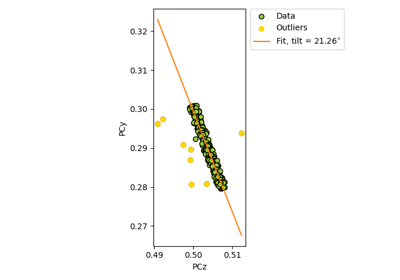estimate_xtilt#
- EBSDDetector.estimate_xtilt(detect_outliers: bool = False, plot: bool = True, degrees: bool = False, return_figure: bool = False, return_outliers: bool = False, figure_kwargs: dict | None = None) float | Tuple[float, ndarray] | Tuple[float, Figure] | Tuple[float, ndarray, Figure][source]#
Estimate the tilt about the detector \(X_d\) axis.
This tilt is assumed to bring the sample plane normal into coincidence with the detector plane normal (but in the opposite direction) [Winkelmann et al., 2020].
See the reference frame tutorial for details on the detector sample geometry.
An estimate is found by linear regression of
pczvs.pcy.- Parameters:
- detect_outliers
Whether to attempt to detect outliers. If
False(default), a linear fit to all points is performed. IfTrue, a robust fit using the RANSAC algorithm is performed instead, which also detects outliers.- plot
Whether to plot data points and the estimated line. Default is
True.- degrees
Whether to return the estimated tilt in radians (
False, default) or degrees (True).- return_figure
Whether to return the plotted figure. Default is
False.- return_outliers
Whether to return a mask with
Truefor PC values considered outliers. Default isFalse. IfTrue,detect_outliersis assumed to beTrueand the value passed is not considered.- figure_kwargs
Keyword arguments passed to
matplotlib.pyplot.Figure()ifplot=True.
- Returns:
x_tiltEstimated tilt about detector \(X_d\) in radians (
degrees=False) or degrees (degrees=True).outliersReturned if
return_outliers=True, in the shape ofnavigation_shape.figReturned if
plot=Trueandreturn_figure=True.
See also
Notes
This method is adapted from Aimo Winkelmann’s function
fit_xtilt()in the xcdskd Python package. See [Winkelmann et al., 2020] for their use of related functions.
